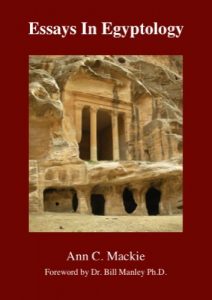This selection of essays covers aspects of the history of Ancient Egypt spanning a period of some 2000 years and includes topics drawn from art, history and religion. The author’s depth of knowledge coupled with her enthusiastic and informative writing style will appeal, not only to those involved in the active study of Egyptology, but also to the casual scholar wishing to gain further knowledge of this fascinating subject. Introduced by internationally renowned Egyptologist and hieroglyph expert, Dr. Bill Manley, this book is a compilation of Ann Mackie’s own university studies and contains a diversity of subject matter and contains:
Chapter One
A study of the evolution of funerary architecture from predynastic pit
graves to the pyramid complexes of the Old Kingdom.
Chapter Two
Comparing the main differences between conceptual and perceptual art including
an outline of the important features of conceptual art to be found in
Egyptian religious art, with particular reference to the scenes in the tomb of Ptahotep.
Chapter Three
The form and function of a typical New Kingdom temple giving specific consideration
to the cosmological and iconographic values of Luxor Temple.
Chapter Four
An outline of the main doctrines of Atenism and the extent to which these
represent entirely new religious concepts in Egypt.
Chapter Five
Examining Egypt’s relationships with Libya and the “Sea Peoples” during the New Kingdom
and their possible contribution to the decline of Egypt’s empire and international standing.
Chapter Six
A dissertation about great royal wives of the later 18th Dynasty.
For the casual reader and also for those involved in the academic study of Egyptology, this book is highly recommended for its wealth of information delivered in an informal yet highly informed text together with supporting illustrations and images.
Cover photography by Ken Buchanan and John Mackie.
Chapter One
A study of the evolution of funerary architecture from predynastic pit
graves to the pyramid complexes of the Old Kingdom.
Chapter Two
Comparing the main differences between conceptual and perceptual art including
an outline of the important features of conceptual art to be found in
Egyptian religious art, with particular reference to the scenes in the tomb of Ptahotep.
Chapter Three
The form and function of a typical New Kingdom temple giving specific consideration
to the cosmological and iconographic values of Luxor Temple.
Chapter Four
An outline of the main doctrines of Atenism and the extent to which these
represent entirely new religious concepts in Egypt.
Chapter Five
Examining Egypt’s relationships with Libya and the “Sea Peoples” during the New Kingdom
and their possible contribution to the decline of Egypt’s empire and international standing.
Chapter Six
A dissertation about great royal wives of the later 18th Dynasty.
For the casual reader and also for those involved in the academic study of Egyptology, this book is highly recommended for its wealth of information delivered in an informal yet highly informed text together with supporting illustrations and images.
Cover photography by Ken Buchanan and John Mackie.






